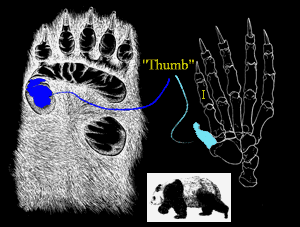
God and Gould
A Student’s Critique of Stephen Jay Gould’s The Panda’s Thumb
“Natural science as a form of thought exists and always has existed in a context of history, and depends on historical thought for its existence…no one can understand natural science unless he understands history.” — R.G. Collingwood, The Idea of Nature
“Nothing seems to annoy scientists more than the suggestion that their work is dependent on or influenced by something outside of science.” — Moishe Gonzales, “Postmodern Biology?”

My familiarity with the work of Stephen Jay Gould stems largely from the reading of essays and reviews of his that have appeared with a fair amount of regularity in The New York Review of Books. It was here that I first encountered his theory of “punctuated equilibria,” which underlies what we have read for today’s class. This theory, referred to by some critics as a sort of “postmodern biology,” essentially amounts to the following: little things do count and can have surprisingly momentous consequences.
To be quite blunt, Gould’s theory is trendy. His postulate of radical contingency as a means by which to reconstruct evolutionary theory sits well with current academic fashions (post-modernism and deconstruction, for example) that similarly seek to posit a radical form of relativism versus the universalist claims of modernity, of which science and, specifically, Darwin are lumped in with. Thus, Gould seeks to “debunk whatever is left in popular consciousness of gradualist and progressivist readings of an evolutionary theory well managed by the hidden hand of natural selection,” as one writer put it. One place in our text to glean Gould’s challenge to Darwinism is on page 33, where Gould writes: “Evolutionists tend to be more comfortable with nonrandom, gradualist theories. I think this is a deep prejudice of Western philosophical traditions, not a reflection of nature’s ways.” Regardless of the merits of this statement--I also happen to believe that many of the Enlightenment’s central tenets no longer carry much weight — we still need to pause, examine and reflect upon the alternatives that Gould and his ilk are proposing. It is my contention that thus far their “remedies” for the pathologies of the Western mindset have proven worse for the patients than the ills that originally beset them.
In Gould’s case it would seem that his chief concern is to dispel this common notion, despite evolution’s secularist implications, Darwin’s project can still be embraced by the religiously faithful; i.e., creationists. In fact, Darwin himself must be counted among this group, for as he states, at the very end of The Origin of Species, in summation: “There is grandeur in this view of life, with its several powers, having been originally breathed by the Creator into a few forms or into one; and that, whilst this planet has gone cycling on according to the fixed law of gravity, from so simple a beginning endless forms most beautiful and most wonderful have been, and are being evolved.” In other words, God’s hand can be found in the very profound complexity of nature, in particular, as Darwin points out, its succinct order.
Gould’s preoccupation with overthrowing this order, and proposing randomness as an alternative means by which to think about evolution, reflects a sense of the times Gould was working in. And as Collingwood has noted, one must not forget that natural science exists within a context of history. Gould’s times were the eighties, which politically, at least for liberal or leftist intellectuals, meant the worst of times. For the eighties saw Ronald Reagan elected as president, and an upsurge in political activity by the religious right, to whom Reagan, it was thought, owed his election. This, it turned out, was pure wish-fulfillment on the part of the left, which Gould, it seems to me, bought hook, line and sinker. How it could be construed that a man with the ethics of Hollywood would work to appease the Bible-thumpers of the South and Midwest is beyond me. And in fact he never did. Gould, in my view, took the “conservative” bait and ran with it.
In the prologue, we get a sense of where Gould sees himself in terms of the debate over evolution. He sees his work as sort of an amalgam of Bateson’s “anarchy” and Darwin’s gradualist, adaptive approach. The latter is referred to by Gould as the “modern synthesis,” understood as “the contemporary version of Darwinism that has reigned for thirty years,” which “took the model of adaptive gene substitution within local populations as an adequate account, by accumulation and extension, of life’s entire history” (Gould 15). Gould' and other like-minded evolutionists are challenging this approach by injecting a little Batesonian anarchy by asserting what Gould calls the “hierarchical view”: “that different levels of evolutionary change often reflect different kinds of causes” (ibid). Or, as he puts it later:
I think we hope for uniformity of causal changes, hence a single, general theory with a Darwinian core. But we must reckon with a multiplicity of mechanisms that preclude the explanation of higher level phenomena by the model of adaptive gene substitution favored for the lowest level. (Gould 16)
Nature’s complexity, Gould says, cannot be reduced to external forces acting up on organisms in such a uniform fashion that their development is inevitably predictable and hence understandable; the lives of organisms are embedded in a history that “constrains their future in myriad, subtle ways (ibid). Or, as I put it earlier, little things in that occur in the history of an organism do count and can have surprising momentous consequences. With respect to human evolution, the implications of Gould’s theory are stark. For if our history, our development, is left to chance, then not not only are we unique, but we are damn lucky to be here at all. If there is no logic to how we evolved, then one slight deviation from what has already taken place could very well have meant our non-existence. The question remaining, however, is whether or not Gould’s thesis still stands if one factors in other important tenets of Darwinism; for example, the view that evolution tends toward organic complexity.
Gould’s trilogy on the issues of perfection only faintly touches on these issues, but it is nonetheless related. On page 20, Gould relates the theme of the trilogy. He claims that our textbooks have generally argued that optimal design in nature illustrates evolution. He counters this “lousy argument” by noting that ideal design “mimics the postulated action of an omnipotent Creator.” Instead, “[o]dd arrangements and funny solutions are the proof of evolution--paths that a sensible God would never tread but that a natural process, constrained by history, follows perforce.” History, for Gould, is, again, not what we are taught in our textbooks, either. History for him is essentially a process heading nowhere; that is, as one writer put it, “insensitive to whatever catastrophes, ruptures and discontinuities [that] may take place in the process.”
So then the panda’s thumb, being what Gould terms an “imperfect sign of history,” gives the lie to the notion of gradualist, adaptive development; it doesn’t make sense. The thumb was an “episodic alteration,” not generated, as Thompson thought, by physical forces, but by what Davis (cited by Gould) sees as an element in a “simple system of generating factors.” The thumb arose from “a set of automatic consequences following a simple enlargement of the radial sesamemoid bone” (43). Thus, instead of perhaps understanding the thumb as a step in the direction of organic complexity and, yes, towards us, Gould thinks it no big deal.
The other chapters obviously follow the outlines of this theme. The “senseless signs of history” of chapter two is a reference to how oddities are the signs of history. For Darwin this meant looking for the remnants of the ancestral stages of present-day organisms. According to Gould, again, Darwin went this route because perfection does not demonstrate evolution. Perfection, as Gould notes, “need not have a history….When history perfects, it covers its own tracks.” Gould then goes on to demonstrate how migration routes of certain animals don’t make sense by modern standards, and are indeed one more sign of history, a remnant of how animals lived when the continents were positioned differently thousands and thousands of years ago.
“Double Trouble,” the title of chapter 3, is a reference to “repeated perfection,” which is an extended reference to what Gould also calls the “convergence theory” of evolution.” This theory is generally held by anti-Darwinian evolutionists, and charges that Darwinism fails to explain the “repeated development of very similar adaptations in different lineages…” (38). Arthur Koestler is cited as one proponent of this theory. According to Gould, he and others are wrong for two reasons. The first is that highly convergent forms of organisms need not be effectively identical; and he trots out the Ichthysaur to prove this. Second, Gould claims that Darwinism is not the “theory of capricious change”that Koestler makes it out to be. Random variation, notes Gould, is but the “raw material of change,” while natural selection plays the important role of constructing good design.
While reading Gould I often felt that he was reading more into Darwin than was truly there. For example, I believe Gould paints Darwin to be much more of a secularist than he actually was. Instructive in this regard is Gould’s citation of Darwin on p.16, a passage that I cited earlier. If one compares Gould’s rendering of that passage with mine, you will discover that Gould’s quotation lacks the reference to the Creator in it, whereas mine, taken directly from the text, does. It would seem that in his earnestness to beat back the Christian right, Gould decided that he need not provide Darwin as grist for their mills.
Questions raised by the reading:
- How sharply does Gould differ from orthodox Darwinism?
- Is Gould’s argument constructed well enough to stand the test of time?
- What does “natural history” mean for Gould?
- What is an appropriate way to study science?
- Would it have made sense for the class to have begun with our contemporary understanding of evolution and worked backward?
- Can evolution be faithfully integrated with creationism? With the Judeo-Christian tradition in general?
“We wish to awaken the feeling of man’s sovereignty by showing his divine birth; this path is now forbidden, since a monkey stands at the entrance.” — Nietzsche
“Our reference for the nobility of manhood will not be lessened by the knowledge, that Man is, in substance and in structure, one with the brutes; for, he alone possesses the marvelous endowment of intelligible and rational speech, whereby, in the secular period of his existence, he has slowly accumulated and organized the experience which is almost wholly lost with the cessation of every individual life in other animals….” — Huxley
Follow-up questions to the study of Darwin, not Gould:
- Was Darwin an inductive thinker, a true scientist?
- What place should religion have with respect to scientific discourse?
- If science cannot be practiced in a purely objective manner, what is the alternative?
- Is speech still the dividing line between humans and apes?


No comments:
Post a Comment